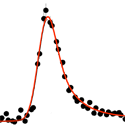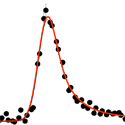Shape shifting in superconductors
Researchers observed long ago that the transition to a superconducting state changes the frequencies and linewidths of acoustic phonons involved in the formation of superconducting electron pairs. The effect is strongest for phonons with energy near the superconducting energy gap because in this region the coupling of phonons and electrons is more strongly impacted by the transition. The line shape, however, was not observed to change from its characteristic Lorentzian profile, a shape that is indicative of the intrinsic phonon lifetime.
This was the picture until deviations of the superconducting line shape from Lorentzian were observed in two borocarbide superconductors in the 1990s. This observation is consistent with a theory developed by Allen et al. [1] in which the electron-phonon coupling includes the mixing of vibrational and electronic excitations into hybrid modes.
Now, Frank Weber of Argonne National Laboratory and Lothar Pintschovius of the Karlsruhe Institute of Technology in Germany report in Physical Review B their use of high-resolution neutron spectroscopy to observe line shape distortions in superconducting niobium. In agreement with the theory of Allen et al., these new data show that the distortions are a general phenomenon and not restricted to one class of superconductors. For phonons close to the superconducting energy gap, these results also show that a precise determination of the gap energy can be made in a single phonon scan. – Brad Rubin
[1] P. B. Allen, V. N. Kostur, N. Takesue, and G. Shirane, Phys. Rev. B 56, 5552 (1997).





